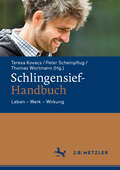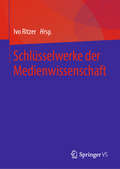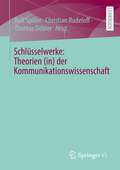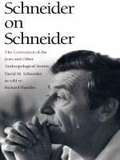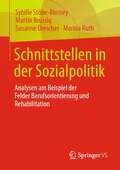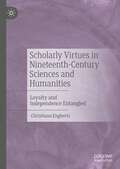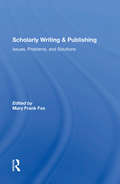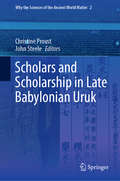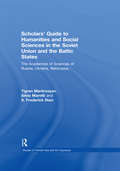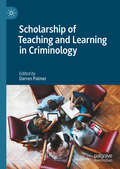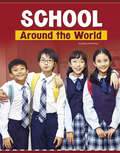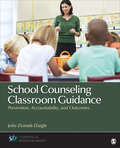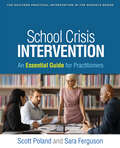- Table View
- List View
Schlingensief-Handbuch: Leben – Werk – Wirkung
by Teresa Kovacs Peter Scheinpflug Thomas WortmannChristoph Schlingensiefs (1960–2010) grenzüberschreitendes Werk umfasst Film, Fernsehen, Theater, Oper, Aktionskunst, Hörspiel, Literatur und Essayistik. Ebenso vielfältig sind seine Themen, die von Nationalsozialismus, Rassismus und Rechtspopulismus zu Kolonialismus, Kapitalismus, Krankheit und Terrorismus reichen. Er war Kult in Deutschlands Sub- und Popkultur, zugleich bespielte er die großen Theater- und Opernhäuser des deutschsprachigen Raums und prägte den Kulturbetrieb von den 1990er Jahren bis zu seinem Tod auf einzigartige Weise. Das einstige ‚enfant terrible‘ ist längst auf dem Weg zum Klassiker. Das Handbuch arbeitet erstmals Leben, Werk und Rezeption des Künstlers umfassend auf.
Schlüsselbegriffe der Sozialplanung und ihre Kritik (Sozialraumforschung und Sozialraumarbeit #23)
by Mario Rund Friedhelm PetersSozialplanung kann eine wichtige Grundlage für die Gestaltung der Lebensbedingungen in denen Städten, Kreisen und Regionen sowie für die Sicherung der kommunalen Daseinsvorsorge darstellen. Wie sie diese Funktion jedoch wahrnimmt, wird maßgeblich von ihren politisch-administrativen Einbettungen sowie ihren inhärenten Rationalitäten und Wissensbeständen bestimmt.Ihre diskursiv verfasste Praxis gilt es gesellschaftstheoretisch und -politisch zu verstehen und zu kontextualisieren. Hierzu möchte der vorliegende Band Anregungen bieten. Daher versammelt er 15 zentrale Begriffe mit denen das Professions- und Handlungsfeld erschlossen werden kann.Der InhaltBeratung – Digitalisierung – Geschlecht / Gender – Gleichwertigkeit – Governance – Integrierte Planung – Kommunale Sozialpolitik – Mobilität – Netzwerke – Partizipation – Sozialberichterstattung – Sozialraum – Sozialraumentwicklung – Steuerung – WirkungDie ZielgruppenLehrende und Studierende der Sozialen Arbeit, der Politik-, Kultur- und Verwaltungswissenschaften sowie der Architektur und der Raumplanung.Praktiker*innen der Sozialplanung, der Sozialen Arbeit, der Sozialraumarbeit, der Stadtteilarbeit, der Gemeinwesenarbeit, des Quartiermanagements u. Ä.Die HerausgeberDr. Mario Rund ist Professor für Soziale Arbeit im Gemeinwesen an der Hochschule Darmstadt.Dr. Friedhelm Peters ist em. Professor für Theorien Sozialer Arbeit an der Fachhochschule Erfurt und der Ev. Hochschule Dresden.
Schlüsselwerke der Emotionssoziologie
by Konstanze Senge Rainer Schützeichel Veronika ZinkEmotionen sind wichtig. Wissenschaftler debattieren disziplinenübergreifend über die Bedeutung von Emotionen in zentralen gesellschaftlichen Bereichen wie dem Finanz- und Wirtschaftsbereich, der Familie und der Religion, der Politik und der Kunst sowie den Medien und der Unterhaltungsindustrie. Der Band greift diesen „emotional turn“ auf und stellt die wichtigen Arbeiten der deutschen und der internationalen Emotionssoziologie und der philosophischen, psychologischen, neurowissenschaftlichen und sozialwissenschaftlichen Emotionsforschung vor. Klassische Autoren werden ebenso berücksichtigt wie zeitgenössische Positionen, theoretische Konzepte ebenso wie empirische Forschungen. Der Band möchte in einer systematischen Weise einen Überblick über den aktuellen Forschungsstand geben.
Schlüsselwerke der Journalismusforschung
by Wiebke Loosen Armin SchollWie in anderen Forschungsfeldern gibt es auch in der Journalismusforschung Schlüsseltexte, die ein Forschungsgebiet erschlossen haben, auf dem weitere Forschung aufbaut. Der Band versammelt solche Schlüsselwerke und stellt sie in Kurzbeschreibungen vor. Zusätzlich werden sie in den Forschungskontext eingebettet und ihre Wirkung auf den weiteren Fortgang der Forschungstradition erläutert. Schließlich werden sie in Bezug auf ihre Bedeutung für aktuelle Fragen und Themen der Journalismusforschung eingeschätzt.
Schlüsselwerke der Medienwissenschaft
by Ivo RitzerDer Band stellt ausgewählte Positionen und zentrale Ideen im disziplinären Rahmen der Medienwissenschaft vor. Schwerpunkte liegen auf medienphilosophischen Ansätzen und einer kulturtheoretischen Perspektive, die sich vor einem dezidiert geisteswissenschaftlichen Horizont konturiert. Dabei versteht der Band sich nicht nur als Handbuch und Nachschlagewerk für Studierende wie Lehrende, er soll vielmehr auch einen eigenen Beitrag zur medienwissenschaftlichen Theoriebildung leisten.
Schlüsselwerke der Werbeforschung
by Nils S. Borchers Tino G. K. Meitz Brigitte NadererWerbung spiegelt als zentraler Gradmesser die disruptiven Veränderungen unserer Medienlandschaft wider. Das vorliegende Werk möchte eine Reflexion dieser Veränderungen und des damit einhergehenden gesellschaftlichen Wandels bieten. Die „Schlüsselwerke der Werbeforschung“ präsentieren daher über einen hundertjährigen Forschungszeitraum die zentralen Werke der Werbeforschung. Sie geben den unterschiedlichen Perspektiven Raum, die die Forschung an die Werbung heranträgt: Von der Entschlüsselung persuasiver Strategien über die kritische Reflexion des gesellschaftlichen Nutzens der Werbung bis zum Beitrag der Werbeforschung in der Methodenentwicklung moderner empirischer Sozialwissenschaften versammeln sie einen umfassenden und interdisziplinären Aufriss der Werbe- und Persuasionsforschung.
Schlüsselwerke: Theorien (in) der Kommunikationswissenschaft
by Thomas Döbler Ralf Spiller Christian RudeloffDer Band gibt eine kompakte Übersicht zu zentralen Theorien (in) der Kommunikationswissenschaft. Insgesamt werden 28 Schlüsselwerke aus der Mikro-, Meso und Makro-Ebene vorgestellt. Ziel ist es, Studierende und Dozierende in den Stand zu versetzen, ein wesentliches Werk in dessen Kontext zu verstehen und in die jeweilige Fachdiskussion einzuordnen. Darüber hinaus wird in diesem Band die Frage diskutiert, welches analytische und empirische Potenzial von den „Klassikern“ in Zeiten digitaler Kommunikation ausgeht.
Schneider on Schneider: The Conversion of the Jews and Other Anthropological Stories
by David M. Schneider Richard HandlerTo listen to David M. Schneider is to hear the voice of American anthropology. To listen at length is to hear much of the discipline's history, from the realities of postwar practice and theory to Schneider's own influence on the development of symbolic and interpretive anthropology in the 1970s and 1980s. Schneider on Schneider offers readers this rare opportunity, and with it an engrossing introduction into a world of intellectual rigor, personal charm, and wit.In this work, based on conversations with Richard Handler, Schneider tells the story of his days devoted to anthropology--as a student of Clyde Kluckhohn and Talcott Parsons and as a writer and teacher whose work on kinship and culture theory revolutionized the discipline. With a master's sense of the telling anecdote, he describes his education at Cornell, Yale, and Harvard, his fieldwork on the Micronesian island of Yap and among the Mescalero Apache, and his years teaching at the London School of Economics, Berkeley, and the University of Chicago. Musing on the current state and the future of anthropology, Schneider's cast of characters reads like a who's who of postwar social science. His reflections on anthropological field research and academic politics address some of the most pressing ethical and epistemological issues facing scholars today, while yielding tales of unexpected amusement.With its humor and irony, its wealth of information and searching questions about the state of anthropology, Schneider on Schneider not only provides an important resource for the history of twentieth-century social science, but also brings to life the entertaining voice of an engaging storyteller.
Schnittstellen der Kinder- und Jugendmedienforschung: Aktuelle Positionen und Perspektiven (Studien zu Kinder- und Jugendliteratur und -medien #1)
by Ute Dettmar Caroline Roeder Ingrid TomkowiakZwischen Kinder- und Jugendliteratur- und -medienforschung und anderen Fachdisziplinen bestehen zahlreiche Schnittstellen. Von diesen ausgehend, werden in dem Band unterschiedliche Perspektiven und Theorieansätze diskutiert und deren Potential für eine literatur- und kulturwissenschaftlich ausgerichtete Kinder- und Jugendliteratur- und -medienforschung beleuchtet. Die 17 Beiträge stellen grundlegende, theoriegeleitete und methodenreflektierte analytische Zugänge zu verschiedenen Untersuchungsgegenständen und Fragestellungen vor. Dabei geht es zum einen darum, den Standort von Kinder- und Jugendliteratur bzw. -medien als Handlungs- und Symbolsystem im kulturellen Archiv auszuloten. Zum anderen werden Ziele gegenwärtiger Forschung diskutiert sowie Aufgaben und Perspektiven zukünftiger Forschungen zur Kinder- und Jugendliteratur entwickelt.
Schnittstellen in der Sozialpolitik: Analysen am Beispiel der Felder Berufsorientierung und Rehabilitation
by Sybille Stöbe-Blossey Marina Ruth Martin Brussig Susanne DrescherSchnittstellen entstehen, wenn es für Menschen in sozialen Risikosituationen Hilfen von unterschiedlichen Institutionen gibt. Das Buch präsentiert empirische Ergebnisse zur Arbeit an Schnittstellen in den Feldern „Berufsorientierung“ und „Rehabilitation“ und legt einen übergreifenden Analyserahmen zur Gestaltung von Schnittstellen im entwickelten Sozialstaat vor.
Schoenberg's Chamber Symphonies: The Crystallization and Rediscovery of a Style
by Catherine DaleThis title was first published in 2000: In this detailed study, Dale (music, U. of Hull) identifies the two chamber symphonies (Opus 9 and Opus 38) that she considers to be pivotal moments in Schoenberg's musical development, and how Opus 38 seeks a reconciliation of tonality and atonality. In addition to analyzing the works, she examines those which preceded Opus 9 and indicate the composer's progression towards atonality. In a similar exploration of pieces surrounding Opus 38, she provides an assessment of the triadic language that became available to the composer in his late tonal and serial works. She also makes reference to Schoenberg's musical sketches, several of which are reproduced in this volume along with other examples from scores.
Scholarly Crimes and Misdemeanors: Violations of Fairness and Trust in the Academic World
by Mark S. Davis Bonnie BerryThis book explores the problem of scientific dishonesty and misconduct – a problem that affects all disciplines, yet whose extent remains largely unknown and for which established standards for reporting, prevention, and punishment are absent. Presenting examples of research misconduct, the authors examine the reasons for its occurrence and address the experience of victimization that is involved, together with the perpetrators’ reactions to being accused. With consideration of the role of witnesses and bystanders, such as book and journal editors and reviewers, students and professional organizations, the book covers the many forms of academic misconduct, offering a theorization of the phenomenon in criminological terms as a particular form of crime, before examining the possibilities that exist for the prevention and control of scholarly crime, as well as implications for further research. An accessible treatment of a problem that remains largely hidden, Scholarly Crimes and Misdemeanors will appeal to readers across disciplines, and particularly those in the social sciences with interests in academic life, research ethics and criminology.
Scholarly Virtues in Nineteenth-Century Sciences and Humanities: Loyalty and Independence Entangled
by Christiaan EngbertsReflecting a growing interest in the history of knowledge, this book explores the importance of scholarly virtues during the late nineteenth century. The practice of science is moulded on notions of scholarly values, such as diligence, impartiality, meticulousness and patience, but here, the author focuses on the virtues of collegial loyalty and critical independence. By analysing how virtues were reflected in day-to-day scholarly work, and examining the possibility that these virtues may have come into conflict with each other, this book sheds light on what is often described as ‘the moral economy of scholarship,’ a metaphor which draws attention to the changeability of the expectations raised by virtue. Highlighting the pre-eminence and exemplary nature of German scholarship during the nineteenth century, the author provides a detailed analysis of four evaluative practices used by scholars across the humanities, social sciences and natural sciences in a number of German universities.This allows a nuanced understanding of the complex relationship between collegial loyalty and critical independence in the academic working environment, and draws comparisons across varying disciplines. A welcome contribution to a growing field of research, this book provides a comparative and transdisciplinary overview of scholarly virtues and will be of interest to those researching the history of science and the humanities.
Scholarly Writing And Publishing: Issues, Problems, And Solutions
by Mary Frank FoxThis book is a major project of the Research and Publications Committee of Sociologists for Women in Society (SWS). SWS has supported the project from its very start with organizational resources and the intellectual contributions of its members. For her early support of the project, we especially thank Roberta Cohen, SWS president, 1982-1984. All royalties from this book will return to SWS. With a belief in the importance of scholarly publishing, the contributors' skill and responsiveness, and the support of SWS and of Westview's staff (especially Deborah Lynes, Jeanne Campbell, Christine Arden, and Sandi Genova), I have found it a pleasure to produce this collection.
Scholars and Scholarship in Late Babylonian Uruk (Why the Sciences of the Ancient World Matter #2)
by Christine Proust John SteeleThis volume explores how scholars wrote, preserved, circulated, and read knowledge in ancient Mesopotamia. It offers an exercise in micro-history that provides a case study for attempting to understand the relationship between scholars and scholarship during this time of great innovation. The papers in this collection focus on tablets written in the city of Uruk in southern Babylonia. These archives come from two different scholarly contexts. One is a private residence inhabited during successive phases by two families of priests who were experts in ritual and medicine. The other is the most important temple in Uruk during the late Achemenid and Hellenistic periods. The contributors undertake detailed studies of this material to explore the scholarly practices of individuals, the connection between different scholarly genres, and the exchange of knowledge between scholars in the city and scholars in other parts of Babylonia and the Greek world. In addition, this collection examines the archives in which the texts were found and the scribes who owned or wrote them. It also considers the interconnections between different genres of knowledge and the range of activities of individual scribes. In doing so, it answers questions of interest not only for the study of Babylonian scholarship but also for the study of ancient Mesopotamian textual culture more generally, and for the study of traditions of written knowledge in the ancient world.
Scholars' Guide to Humanities and Social Sciences in the Soviet Union and the Baltic States: The Academies of Sciences of Russia, Ukraine, Belorussia, Moldova, the Transcaucasian and Central Asian Republics and Estonia, Latvia and Lithuania (Studies of Central Asia and the Caucasus)
by S. Frederick Starr Tigran Martirosyan Silvia MarettiIn the years since the first edition of the "Guide" was published, the research institutions of the academies of sciences of the USSR and the republics have undergone several, sometimes radical, reorganizations and reaffiliations. This guide to academy institutions supplies names, addresses, and historical, research, and organizational profiles for each institution, with summary information on staffing, current projects, special facilities, and libraries. The end of the Cold War has brought with it many changes of attitude and policy in the political arena; however, nowhere has change been so emotionally charged as in the area of politically-based emigration. Refugee policy is the driving force behind many of today's headlines, influencing both foreign and domestic policy. In Desperate Crossings, authors Norman L. and Naomi Flink Zucker chronicle and analyze the phenomenon of mass escape that began with the Haitians, but exploded into the American consciousness in the spring of 1980 with the Mariel boatlift and the subsequent mass exodus from Central America, and was most recently manifested in the Haitian and Cuban exoduses of 1994. In a compelling and carefully documented narrative, they identify the troika of interests - foreign policy, domestic pressures, and costs - that have controlled and determined the American response to refugees since before the Second World War, continuing until today. Desperate Crossings concludes by proposing a comprehensive and politically palatable approach to future refugee flows, both in our hemisphere and for the world community-at-large - including Europe and Asia. The authors suggest how, by changing the course of its refugee policies and programs, the United States can better respond to both the needs of refugees and the demands of its citizens.
Scholarship of Teaching and Learning in Criminology
by Darren PalmerThis book is the first dedicated collection aimed at examining teaching and learning issues within criminology. This collection of essays identifies how criminological practices are being shaped by larger developments and changes within the field of scholarship on teaching and learning. Changes include an increased university focus on ‘good teaching’ rankings and the associated emphasis on the professional development of teaching staff in order to shape them. In the past decade government funding for teaching and learning awards, and the move to sector funding on the basis of ‘good teaching’ outcomes (student satisfaction, completion rates, etc.), have further fostered developments in teaching and learning practices and the associated scholarship. However, criminology lags behind in responding to these changes. Scholarship of Teaching and Learning in Criminology aims to fill this gap by examining teaching practices in the hope of fostering a new generation of publications dedicated to scholarship on teaching and learning within the field.
Scholarship, Money, and Prose: Behind the Scenes at an Academic Journal
by Michael ChibnikAn illuminating guide to publishing a scholarly journal written by a former editor-in-chiefAmerican Anthropologist is the flagship journal of the American Anthropological Association, published quarterly, reaching more than 12,000 readers with each issue and representing four distinct subfields. The journal publishes articles that add to, integrate, synthesize, and interpret anthropological knowledge; commentaries and essays on issues of importance to the discipline; and reviews of books, films, sound recordings, and exhibits. From 2012 to 2016, Michael Chibnik was editor-in-chief of American Anthropologist. In Scholarship, Money, and Prose, he writes a candid account of the complex and challenging work entailed in its production.Providing detailed ethnographic and historical descriptions of the operations of a major journal and behind-the-scenes anecdotes of his experiences, Chibnik makes transparent the work of an editor-in-chief. He reveals how he assembled diverse materials, assessed contradictory peer reviews of manuscripts submitted for publication, and collaborated with authors to improve the legibility and clarity of their articles. He also examines controversies that emerged from his columns on open access and biological anthropology and the inclusion of politically charged material in the journal.Scholarship, Money, and Prose sheds light on two aspects of successful editing that are common to academic journals whatever their subject matter. The first task is to strike a balance among different theoretical perspectives and topical specialties. This pressure is particularly salient in a field like anthropology in which scholars differ greatly in the extent to which they adopt a scientific or humanistic perspective. Second, editors must attend carefully to the need to keep costs down and revenues up in an economic environment in which libraries are cutting subscriptions and publishers are considering the future sustainability of journals. Relevant to a wide range of disciplines, Scholarship, Money, and Prose serves as a window onto the past, present, and future of scholarly publishing.
School Around the World (Customs Around the World)
by Mary MeinkingLearning is important no matter where you are. But some classrooms are very different than others. Discover all types of schools around the world in this fun, engaging series that develops kids' understanding of our diverse global community and their place in it.
School Behavioral Health: Interconnecting Comprehensive School Mental Health and Positive Behavior Support
by Mark D. Weist Kathleen B. Franke Robert N. StevensThis book examines the prevalence of emotional and behavioral problems in youth and the implications of little or low-quality mental health services available for them. It describes aspects of Positive Behavioral Interventions and Supports (PBIS) and school mental health (SMH) that work together to form a comprehensive service delivery model called the Interconnected Systems Framework (ISF). The term school behavioral health (SBH) is used to describe SMH and PBIS working together, as in the ISF. The book examines perspectives of key stakeholders through a series of research forums, during which participants identified critical themes for the advancement of SBH in South Carolina and the southeast region of the United States. Chapters address key themes of school behavioral health from these forums, such as collaboration, schoolwide approaches, quality of services, and support for specific populations, including military families and youth involved in the juvenile justice and child welfare systems. The book addresses barriers to providing behavioral health services at school as well as recommendations from key stakeholders for advancing SBH along these critical dimensions. This volume is a must-have resource for researchers, professors, and graduate students as well as practitioners, clinicians, and therapists across such interrelated disciplines as clinical child and school psychology, educational policy and politics, social work, public health, school counseling, family studies, juvenile justice, child and adolescent psychiatry, and child welfare and well-being services.
School Broadcasting in Canada
by Richard LambertThis book describes the origin, growth, and achievements of school broadcasting in Canada. Sections are devoted to the start of school broadcasting in each province, the establishment of national school broadcasts, and the work of the National Advisory Council on School Broadcasting. In the story, the part played by the Canadian Broadcasting Corporation in initiating and promoting the work of teaching by radio and in providing the facilities upon which it is based, is a significant one. The book is the first authoritative description, by the man largely responsible for its success, of an important and fruitful experiment in federal-provincial co-operation in the thorny field of education. To this co-operation is due the high standard of the school broadcasts which have earned for Canada world-wide recognition and appreciation. The book also describes the international aspects of this cooperation, particularly between Canada and Australia, Great Britain, and the United States.
School Consultation
by Brian K. Martens William P. ErchulSince its emergence during the 1960s, school consultation has become an important vehicle for delivering psychological and educational services. Cooperative efforts between skilled consultants and teachers, rooted in the principles of problem solving, social influence, and professional development, enhance student learning and adjustment while encouraging consultees to be more effective and proactive in their practice. The Third Edition of School Consultation: Conceptual and Empirical Bases of Practice shows in expert detail how this relationship works by synthesizing mental health and behavioral models of consultation with the most effective evidence-based practices (e.g., implementation support, response to intervention) informing the field today. The authors provide real-world contexts for all participants in the equation--consultants, teachers, students, staff, and the school itself--and thoroughly review consultation processes and outcomes for a contemporary practice-oriented approach suited to the new consultant, trainee, or researcher. Key features of the Third Edition include: An integrated mental health/behavioral model for school consultation.An organizational study of the school as a setting for consultation.Assessment issues and strategies particularly relevant to school consultation.Approaches to providing teachers with implementation support. Conceptual models for selecting academic and behavioral interventions.Administrative perspectives on school consultation.A real, transcribed case study analyzed by the authors.In the tradition of its predecessors, School Consultation, Third Edition, is a confidence-building tool for practitioners in school psychology, clinical child psychology, educational specialties, school counseling, special education, and school social work as well as a trusted reference for researchers in these fields.
School Counseling Classroom Guidance: Prevention, Accountability, and Outcomes (Counseling and Professional Identity)
by Jolie Ziomek-Daigle"Finally, a text that thoroughly covers the topic of classroom guidance – an effective tool for every school counselor at every school level." –Tiffany Bates, Louisiana Tech University Intended for school counselors to aid in the learning of developmental classroom guidance, School Counseling Classroom Guidance: Prevention, Accountability, and Outcomes teaches the fundamentals, strategies, and research outcomes of classroom guidance programming for comprehensive, developmentally appropriate school counseling programs. The content of this book looks at the history and fundamentals of classroom guidance, how these activities meet CACREP and ASCA standards, how and why activities should be aligned to the larger academic curriculum and state/national teaching standards, recommendations on how to develop and assess classroom guidance units, a sampling of units and lessons, techniques in managing the classroom, and outcome research and trends. School Counseling Classroom Guidance: Prevention, Accountability, and Outcomes is part of the Counseling and Professional Identity Series, which targets specific competencies identified by CACREP (Council for Accreditation of Counseling and Related Programs).
School Counseling Classroom Guidance: Prevention, Accountability, and Outcomes (Counseling and Professional Identity)
by Jolie Ziomek-Daigle"Finally, a text that thoroughly covers the topic of classroom guidance – an effective tool for every school counselor at every school level." –Tiffany Bates, Louisiana Tech University Intended for school counselors to aid in the learning of developmental classroom guidance, School Counseling Classroom Guidance: Prevention, Accountability, and Outcomes teaches the fundamentals, strategies, and research outcomes of classroom guidance programming for comprehensive, developmentally appropriate school counseling programs. The content of this book looks at the history and fundamentals of classroom guidance, how these activities meet CACREP and ASCA standards, how and why activities should be aligned to the larger academic curriculum and state/national teaching standards, recommendations on how to develop and assess classroom guidance units, a sampling of units and lessons, techniques in managing the classroom, and outcome research and trends. School Counseling Classroom Guidance: Prevention, Accountability, and Outcomes is part of the Counseling and Professional Identity Series, which targets specific competencies identified by CACREP (Council for Accreditation of Counseling and Related Programs).
School Crisis Intervention: An Essential Guide for Practitioners (The Guilford Practical Intervention in the Schools Series)
by Sara Ferguson Scott PolandProviding vital tools to enhance preparedness in any school setting (K–12), this book is grounded in state-of-the-art research and real-world experience. Foremost authority Scott Poland and frontline clinician Sara Ferguson address all aspects of team-based crisis intervention and postvention. With a key focus on prevention, the book describes ways to identify risk factors and enhance students' mental health, connectedness, and resilience. Best practices are outlined for responding effectively to specific crises, including unexpected deaths in the school community, youth suicide, school violence, and natural disasters. In a convenient large-size format, the book includes firsthand perspectives from other experts in the field, hands-on strategies to support daily practice, and 23 reproducible forms that can be downloaded and printed. This book is in The Guilford Practical Intervention in the Schools Series, edited by Sandra M. Chafouleas.
